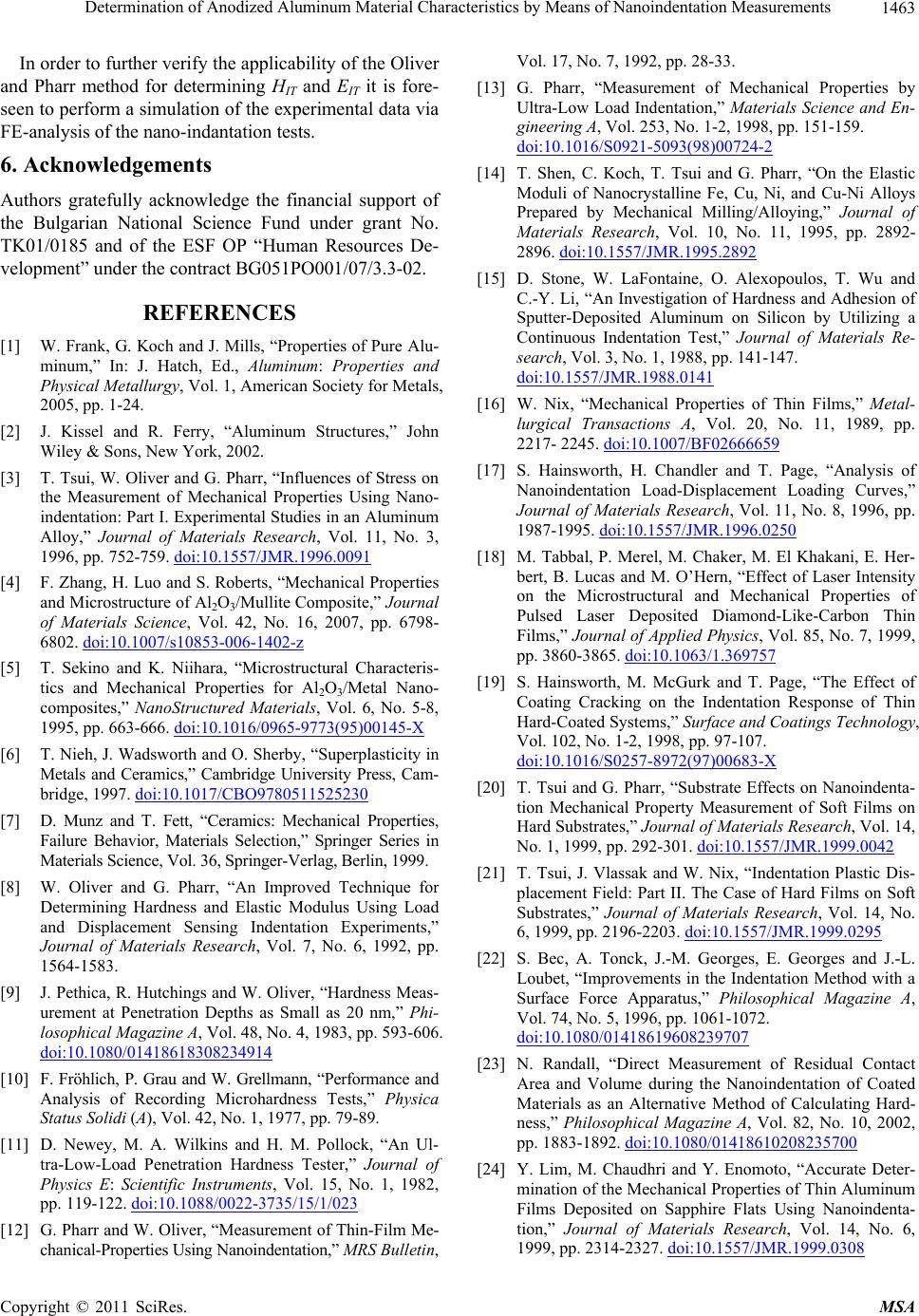
Determination of Anodized Aluminum Material Characteristics by Means of Nanoindentation Measurements1463
In order to further verify the applicability of the Oliver
and Pharr method for determining HIT and EIT it is fore-
seen to perform a simulation of the experimental data via
FE-analysis of the nano-indantation tests.
6. Acknowledgements
Authors gratefully acknowledge the financial support of
the Bulgarian National Science Fund under grant No.
TK01/0185 and of the ESF OP “Human Resources De-
velopment” under the contract BG051PO001/07/3.3-02.
REFERENCES
[1] W. Frank, G. Koch and J. Mills, “Properties of Pure Alu-
minum,” In: J. Hatch, Ed., Aluminum: Properties and
Physical Metallurgy, Vol. 1, American Society for Metals,
2005, pp. 1-24.
[2] J. Kissel and R. Ferry, “Aluminum Structures,” John
Wiley & Sons, New York, 2002.
[3] T. Tsui, W. Oliver and G. Pharr, “Influences of Stress on
the Measuremen
indentation: Part I. Experimental Studies in an Aluminum
t of Mechanical Properties Using Nano-
Alloy,” Journal of Materials Research, Vol. 11, No. 3,
1996, pp. 752-759. doi:10.1557/JMR.1996.0091
[4] F. Zhang, H. Luo and S. Roberts, “Mechanical Properties
and Microstructure of Al2O3/Mullite Composite,” Journal
of Materials Science, Vol. 42, No. 16, 2007, pp. 6798-
6802. doi:10.1007/s10853-006-1402-z
[5] T. Sekino and K. Niihara, “Microstructural Characteris-
tics and Mechanical Properties for Al2O3/Metal Nano-
composites,” NanoStructured Materials, No. 5-8,
1995, pp. 663-666. doi:10.1016/0965-9773(95)00145-X
, Vol. 6
[6] T. Nieh, J. Wadsworth and O. Sherby, “Superplasticity in
Metals and Ceramics,” Cambridge University Press, Cam-
bridge, 1997. doi:10.1017/CBO9780511525230
[7] D. Munz and T. Fett, “Ceramics: Mechanical Properties,
Failure Behavior, Materials Selection,” Springer Series in
Materials Science, Vol. 36, Springer-Verlag, Berlin, 1999.
[8] W. Oliver and G. Pharr, “An Improved Technique for
Determining Hardness and Elastic Modulus Using Load
and Displacement Sensing Indentation Experiments,”
Journal of Materials Research, Vol. 7, No. 6, 1992, pp.
1564-1583.
[9] J. Pethica, R. Hutchings and W. Oliver, “Hardness Meas-
urement at Penetration Depths as Small as 20 nm,” Phi-
losophical Magazine A, Vol. 48, No. 4, 1983, pp. 593-606.
doi:10.1080/01418618308234914
[10] F. Fröhlich, P. Grau and W. Grellmann, “Performance and
Analysis of Recording Microhardness Tests,” Physica
Status Solidi (A), Vol. 42, No. 1, 1977, pp. 79-89.
[11] D. Newey, M. A. Wilkins and H. M. Pollock, “An Ul-
tra-Low-Load Penetration Hardness Tester,” Journal of
uments, Vol. 15, No. 1, 1982
022-3735/15/1/023
Physics E: Scientific Instr
pp. 119-122. doi:10.1088/0
,
Vol. 17, No. 7, 1992, pp. 28-33.
[13] G. Pharr, “Measurement of Mechanical Properties by
Ultra-Low Load Indentation,” Materials Science and En-
gineering A, Vol. 253, No. 1-2, 1998, pp. 151-159.
doi:10.1016/S0921-5093(98)00724-2
[14] T. Shen, C. Koch, T. Tsui and G. Pharr, “On the Elastic
Moduli of Nanocrystalline Fe, Cu, Ni, and Cu-Ni Alloys
Prepared by Mechanical Milling/Alloying,” Journal of
Materials Research, Vol. 10, No. 11, 1995, pp. 2892-
2896. doi:10.1557/JMR.1995.2892
[15] D. Stone, W. LaFontaine, O. Alexopoulos, T. Wu and
C.-Y. Li, “An Investigation of Hardness and Adhesion of
Sputter-Deposited Aluminum on Silicon by Utilizing a
Continuous Indentation Test,” Journal of Materials Re-
search, Vol. 3, No. 1, 1988, pp. 141-147.
doi:10.1557/JMR.1988.0141
[16] W. Nix, “Mechanical Properties of Thin Films,” Metal-
lurgical Transactions A, Vol. 20, No. 11, 1989, pp.
2217- 2245. doi:10.1007/BF02666659
[17] S. Hainsworth, H. Chandler and T. Page“Analysis of
t Loading Curves,”
, 1996, pp.
[12] G. Pharr and W. Oliver, “Measurement of Thin-Film Me-
chanical-Properties Using Nanoindentation,” MRS Bulletin,
,
Nanoindentation Load-Displacemen
Journal of Materials Research, Vol. 11, No. 8
1987-1995. doi:10.1557/JMR.1996.0250
[18] M. Tabbal, P. Merel, M. Chaker, M. El Khakani, E. Her-
bert, B. Lucas and M. O’Hern, “Effect of Laser Intensity
on the Microical Properties of
Pulsed LaserLike-Carbon Thin
structural and Mechan
Deposited Diamond-
Films,” Journal of Applied Physics, Vol. 85, No. 7, 1999,
pp. 3860-3865. doi:10.1063/1.369757
[19] S. Hainsworth, M. McGurk and T. Page, “The Effect of
Coating Cracking on the Indentation Response of Thin
Hard-Coated Systems,” Surface and Coatings Technology,
Vol. 102, No. 1-2, 1998, pp. 97-107.
doi:10.1016/S0257-8972(97)00683-X
[20] T. Tsui and G. Pharr, “Substrate Effects on Nanoindenta-
tion Mechanical Property Measurement of Soft Films on
Hard Substrates,” Journal of Materials Research, Vol. 14,
No. 1, 1999, pp. 292-301. doi:10.1557/JMR.1999.0042
[21] T. Tsui, J. Vlassak and W. Nix, “Indentation Plastic Dis-
placement Field: Part II. The Case of Hard Films on Soft
Substrates,” Journal of Materials Research, Vol. 14, No.
6, 1999, pp. 2196-2203. doi:10.1557/JMR.1999.0295
[22] S. Bec, A. Tonck, J.-M. Georges, E. Georges and J.-L.
Loubet, “Improvements in the Indentation Method with a
Surface Force Apparatus,” Philosophical Magazine A,
Vol. 74, No. 5, 1996, pp. 1061-1072.
doi:10.1080/01418619608239707
[23] N. Randall, “Direct Measurement of Residual Contact
Area and Volume during the Nanoindentation of Coated
Materials as an Alternative Method of Calculating Hard-
ness,” Philosophical Magazine A, Vol. 82, No. 10, 2002,
pp. 1883-1892. doi:10.1080/01418610208235700
[24] Y. Lim, M. Chaudhri and Y. Enomoto, “Accurate Deter-
mination of the Mechanical Properties of Thin Aluminum
Films Deposited on Sapphire Flats Using Nanoindenta-
tion,” Journal of Materials Research, Vol. 14, No. 6,
1999, pp. 2314-2327. doi:10.1557/JMR.1999.0308
Copyright © 2011 SciRes. MSA